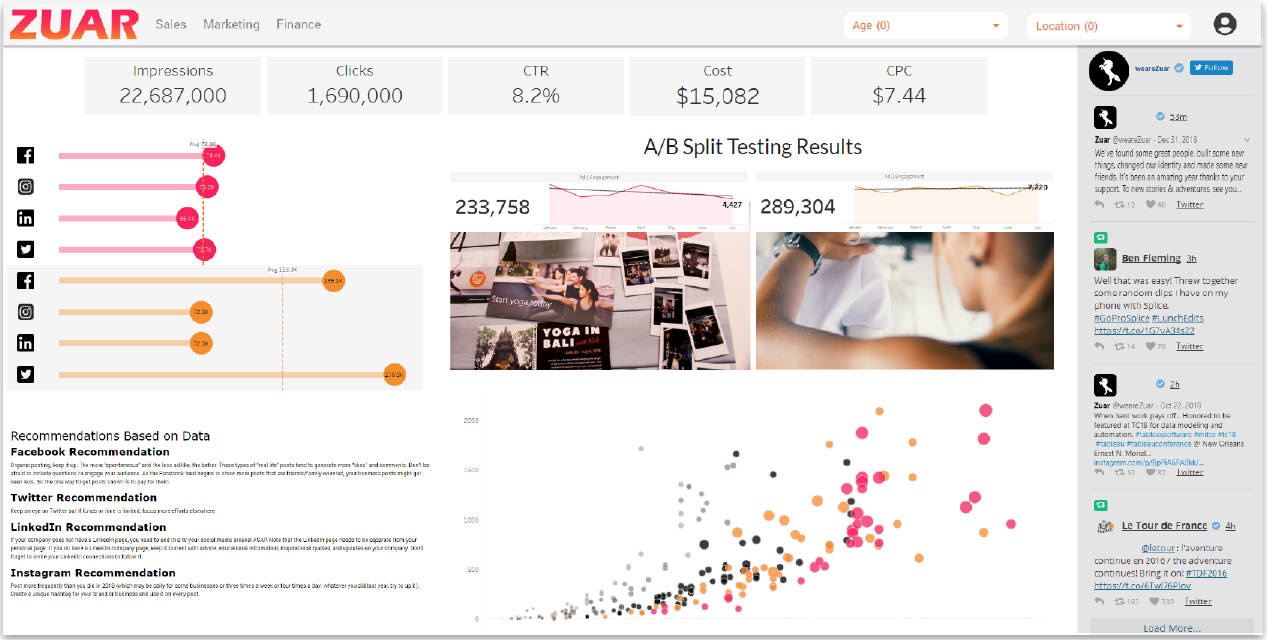6 Downsides of the Modern Data Stack
The modern data stack (MDS) can be a powerful solution for many businesses. However, the downsides must be considered. In this article, Zuar lays out 6 key disadvantages to the MDS.

Introduction to the Modern Data Stack
The modern data stack (MDS) has revolutionized the way organizations collect, process, and analyze data. Its modular approach—combining tools for data ingestion, transformation, storage, and visualization—offers flexibility and scalability.
But behind the glossy promises lies a set of challenges that can derail data initiatives and strain budgets. This article will cover six downsides that Zuar has identified in many organizations' modern data stacks.
For organizations seeking a simpler, more efficient way to manage their data workflows, an all-in-one platform like Zuar offers a compelling alternative. In this article, we’ll explore the key downsides of the modern data stack and how Zuar addresses these pain points.

1. Multiple Vendor Relationships
With the modern data stack, organizations often work with a multitude of vendors. For instance, you might use one provider for ETL (extract, transform, load), another for data warehousing, and yet another for business intelligence.
This approach can lead to several challenges:
- Integration Complexity: Integrating disparate systems from different vendors can be a complex and time-consuming process. Each vendor may have its own proprietary APIs, data formats, and integration protocols, making it difficult to ensure seamless data flow and interoperability between components.
- Maintenance Challenges: When you string tools together, you’re responsible for ensuring they continue to work seamlessly over time. Updates, changes, or compatibility issues across systems can create a significant maintenance burden.
- Inconsistent Support: Working with multiple vendors can lead to inconsistent support experiences. Each vendor may have different support processes, response times, and levels of expertise, making it difficult to receive cohesive and timely support when issues arise.

2. No Single Point of Accountability
In a modular MDS, no single vendor is accountable for the system as a whole. When issues arise, the burden falls on your team to troubleshoot across multiple platforms and vendors.
This “not-my-problem” dynamic can lead to prolonged downtime, frustrated teams, and missed opportunities. It’s not uncommon for vendors to point fingers at each other, leaving you stuck in the middle.
Furthermore, with multiple vendors involved, it becomes difficult to establish clear lines of communication and escalation paths. Organizations may find themselves navigating a maze of support channels, further exacerbating the issue and delaying resolution.
The absence of a single point of accountability can also hinder proactive maintenance and optimization efforts. Without a unified approach, identifying areas for improvement or implementing best practices becomes a complex endeavor, as each vendor operates within their own silo.

3. Unpredictable Pricing
One of the major drawbacks of a modular MDS the unpredictable and often complex pricing models.
With multiple vendors involved, each with their own pricing structures, it becomes a daunting task to accurately forecast and budget for data infrastructure costs.
This unpredictability can lead to unexpected expenses, making it challenging to plan and allocate resources effectively.
Each vendor may have different pricing tiers, usage-based charges, and hidden fees, resulting in a convoluted pricing landscape. As data volumes and user demands fluctuate, the costs associated with the a modular MDS can escalate rapidly, leading to budget overruns and financial strain.

4. Costly Mistakes
Variable pricing models in the MDS mean that mistakes—like running an inefficient query or misconfiguring a data pipeline—can be expensive. These errors can quickly escalate costs, often without immediate detection.
Cost overruns from avoidable mistakes can erode trust in your data initiatives and diminish their ROI. Teams may become hesitant to experiment or innovate, fearing financial repercussions.
Beyond financial loss, these mistakes can also result in operational disruptions, delayed projects, and strained relationships with internal and external stakeholders. In some cases, such errors could compromise data accuracy, leading to flawed insights and poor decision-making.

5. Limited Technical Features
Many MDS tools rely on shared infrastructure and hardware to keep costs low. While this approach is cost-effective, it often comes at the expense of technical capabilities.
When multiple companies share the same infrastructure resources, it becomes challenging for vendors to offer highly customized or advanced features that cater to specific business needs.
Shared infrastructure inherently imposes constraints on the level of customization and scalability that can be achieved. Users are essentially confined to the capabilities and limitations defined by the vendor's shared environment.
This can result in compromises, as businesses may need to adapt their processes or workflows to fit the available features rather than having the flexibility to tailor the system to their exact requirements.

6. Lack of Access to Underlying Code
Many MDS tools are “wizard-driven,” providing users with pre-built workflows and interfaces but no access to the underlying code. While this simplifies basic tasks, it limits customization and control.
Without access to the underlying code, teams are often forced to work around the limitations of pre-configured workflows, which can result in inefficiencies and reduced effectiveness.
This lack of transparency can also make debugging more difficult, as users are unable to identify the root cause of an issue within the "black box" of the tool’s functionality.
Additionally, organizations seeking to align their data workflows with specific compliance or industry standards may find themselves constrained by the rigidity of wizard-driven solutions.

Why Zuar Is the Ideal Solution

Zuar isn’t just an alternative to the modern data stack—it’s a better way forward. By consolidating your data operations into a single, integrated platform, Zuar eliminates the inefficiencies and frustrations that come with managing a fragmented MDS.
The Zuar Platform combines two core components: Zuar Portal and Zuar Runner. Zuar Portal serves as a customizable, white-labeled analytics portal that enables organizations to securely share and visualize data with stakeholders.
On the backend, Zuar Runner automates data workflows by extracting, transforming, and loading data from various sources into centralized locations.
Together, these tools create a seamless, integrated ecosystem that addresses the challenges of the modern data stack while enhancing usability, performance, and flexibility.
Here’s what you can expect with Zuar:
- Simplicity: Manage your entire data workflow from one platform.
- Accountability: Enjoy a single point of contact for all your data needs.
- Transparency: Predictable pricing that aligns with your budget.
- Performance: Dedicated resources and advanced features that scale with your business.
- Flexibility: Tools and interfaces that cater to both technical and non-technical users.
By addressing the key downsides of the modern data stack, Zuar empowers organizations to focus on what truly matters: turning data into actionable insights.
Learn how the Zuar Platform can transform you business by meeting with someone from our team. Or start a free two-week trial:



